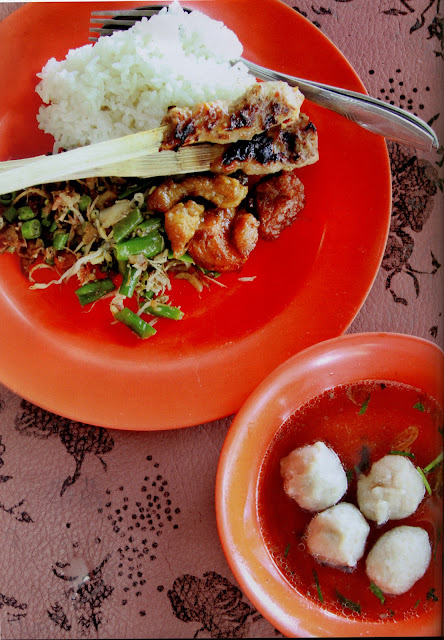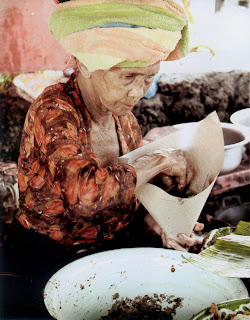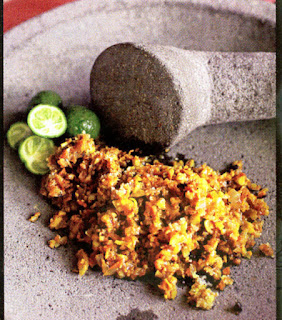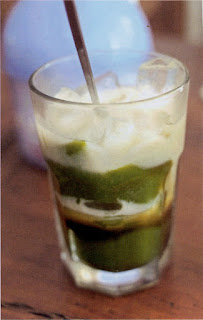chef Will Meyrick shows you
a different side of Bali’s capital, Denpasar
It’s 9.15am, but I’m too late. Ibu Mangku has already almost
sold out. All that’s left of her famous babi guling (slow roasted
suckling pig) are a few remnants. Enough for me, it turns out. Whew.
While
I’m eating, Ibu Mangku is
already busy bundling up 100 bungkus (folded paper take away parcels) of
her equally popular satay. When she tells me that they make up to 300 bungkus and 9,000 satay sticks a
day; I almost fall off the bench. This humble “holy man’s wife” (the English
translation of ibu mangku) is quite the culinary entrepreneur it would seem.
The
warung (small roadside
restaurant) Babi Guling Gerenceng also dishes up a great early lunch. Shoes off though, because seating here
is lesehan style on rattan
floor mats. If you’re a babi guling aficionado and love your crackling though, then this is one stop you
definitely want to make.
At Warung Selumbung, the satay is sweet
and peppery, and easily polished off in a few bites. Bobbing in a bowl of clear
broth, the bakso (meatballs) take me by surprise. So floury and springy, it’s almost like eating gnocchi. I was just as
stumped by their lawar. It’s a delicate, chopped-up tumble of long beans, bean sprouts, roasted coconut chunks, pork,
deep-fried garlic, finely grated fresh coconut, zingy lemo (a tiny local citrus fruit similar to lime but with a whole lot
more punch) and bumbu gede. The ingredients are a line-up of the usual suspects, but done with a
twist.
Afterwards, an ice-cold
es daluman at Warung Mayra hits the spot. The
wobbly, forest-green drink is a refreshing mash-up of daluman leaf jelly
(the leaves are soaked in water and then squeezed, the liquid setting overnight
from the natural gelatin) and palm sugar with coconut milk. Another must try
here is the tipat cantok. It’s a mix of green beans, mung-bean sprouts, freshly made tofu, deep-fried garlic, ketupat (soft rice cakes shaped in banana-leaf parcels) and peanut sauce.
It’s a little sweet, a little spicy and a little sour, all at the same time, just as it should be. Meanwhile, the kluwak- infused broth of the jukut undis (black-bean soup) is
simple and earthy, and one of the best I’ve tried. The rujak here is a winner
too. Like a savoury fruit salad, rough-cut slices of raw green mango,
pineapple, cassava, cucumber and sweet potato are tossed together in a hot and
spicy dressing. It’s Bali’s very rustic take on its more famous and only distantly related
Thai cousin, som tum.
Now you can’t miss Warung Betutu Gilimanuk. The scary looking
clown (sporting fun, frangipani-decorated ears, no less) on the eatery’s signage let’s you know you’ve reached the right
place. It’s all about the betutu here. Marinated in a killer bumbu gede, the bebek betutu (roasted duck) is
slow braised until it’s so soft and tender that it seems to melt off the bones
as you eat it. This one is eye-wateringly spicy, but oh-so-good.
For the braver
gastronomes, a must-try is the sate kakul. Small freshwater snails, they are one of Ball’s most unique regional
specialties. Skewered onto satay sticks and served with roasted peanut sauce, they’re also chewier
than I had imagined. At the other end of the texture spectrum, deep-fried baby eels offer a
satisfying crunch alongside a plate of dark green sayur gonda (blanched
watercress), which tastes cleansing and bittersweet.
The
essence of real Balinese food is about what is found and foraged. Starfruit leaves, cassava
leaves, wild greens, young fern tips, ginger flowers, banana stems and raw forest herbs all have starring parts.
The herbs and vegetables are often raw. Nuts are used generously. It’s like the
original Paleo diet, Balinese style, and there’s not a
curry in sight.
This is why the older
generations of Balinese are so robust and spritely. They’ve got a twinkle in their eyes and a deep understanding of
the
natural culinary world around them. They were cooking in the days when snails
and baby eels weren’t farmed, but fished out of rice paddies, with ducks being
the pesticide of choice. When animals were free range and hand reared, the meat
was fresh and ethically produced. Traditionally organic, you might say. We’d
all be a lot healthier and happier if we returned to those ways.
My last stops of the
day take me into the neighbourhood of Kereneng Market, another place worth exploring for its amazing stalls of soto and satay. Here, I devour some mie pangsit (handmade noodles)
at Warung Mastok, before finally finishing up with a bowl of nourishing soto ceker (chicken-feet soup)
around the corner at Soto Purnama.
Denpasar is a humble place.
It’s not trying to be anything its not, which is part of its charm. Like most
cities though, you only really discover its stories and secrets if you’re
prepared to wander off the beaten track. Travel globally, eat locally!
Garuda Magazine 12.12









Tidak ada komentar:
Posting Komentar